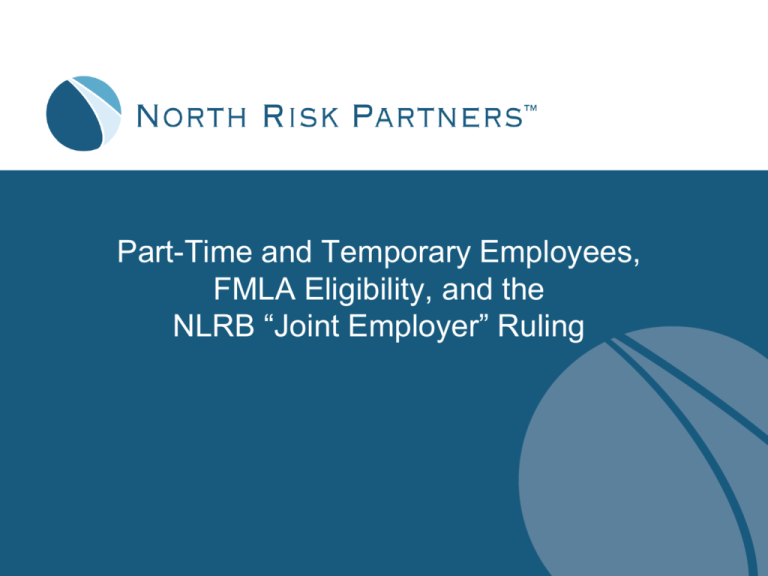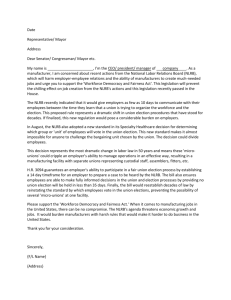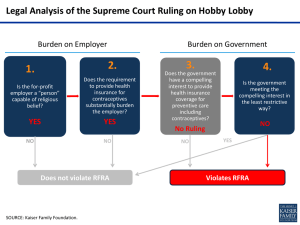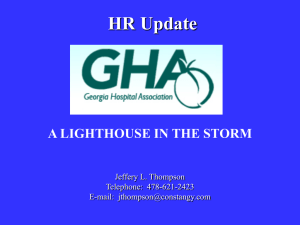Slides - North Risk Partners
advertisement

Part-Time and Temporary Employees, FMLA Eligibility, and the NLRB “Joint Employer” Ruling Presented by: Mike Bourgon Mike Conroy Part-Time, Temporary and Seasonal Employees Introduction Part-Time Employees Employers often hire part-time or temporary workers to help with increased work demands or seasonal industry fluctuations that sometimes occur in certain industries. Most states define part-time employees as those who work less than 35 hours per week, compared to full-time employees who typically work for 40 hours or more. Introduction Part-time employees are typically paid on an hourly basis, and must comply with company rules, policies and obligations, such as performance goals, safety rules, and company business practices. Even so, part-time employees generally have limited or no company benefits, such as health benefits, vacation and sick time, paid holidays, and unemployment compensation, among others, unless required by state labor laws and/or company policies. Introduction Under federal laws, part-time employees are treated the same as full-time employees under the Fair Labor Standards Act (FLSA) concerning minimum wage, overtime pay, recordkeeping and child labor. In addition, part-time employees are covered under OSHA’s safety and health policies concerning work-related injuries, illnesses, and occupational fatalities. Under the Employee Retirement Income Security Act (ERISA), part-time employees who work 1,000 hours or more during a calendar year may be eligible for retirement benefits. Introduction Temporary Employees Temporary employees are typically hired to cover for absent employees (such as those who are on maternity or disability leave) and temporary vacancies, or to fill gaps in a company’s workforce. Temporary employees may be hired directly or through a temporary staffing agency – in which case the temp is on lease with the staffing company, but not an employee of the client company that uses its services. FMLA FAQ: Does Temporary Employment Count Toward FMLA Eligibility? Does Temporary Employment Count Toward FMLA Eligibility? Q: We regularly utilize temporary employees, some of whom we hire permanently. Does the time they work as a temp (through an agency) count toward the 12-month and 1,250 hour eligibility requirements? Does Temporary Employment Count Toward FMLA Eligibility? A: An employee is eligible to take FMLA leave when, among other things, he/she has worked for the employer for 12 months (which, of course, need not be consecutive) and worked 1,250 hours in the previous 12-month period. Does Temporary Employment Count Toward FMLA Eligibility? According to the Department of Labor, the time worked as a temporary employee does indeed count toward the 12-month service and 1,250 hour requirement. In one short sentence in the FMLA regulations, the DOL sums up its position: “joint employment will ordinarily be found to exist when a temporary placement agency supplies employees to a secondary employer.” 29 C.F.R. 825.106(b)(1) Does Temporary Employment Count Toward FMLA Eligibility? This position is only further cemented by a long-standing 1994 DOL opinion letter, in which the agency confirmed that “the time that the employee was employed by the temporary help agency would be counted towards the eligibility tests” under the FMLA. The courts generally have agreed with DOL’s position. Mackey v. Unity Health System (finding that, for FMLA eligibility purposes, “an employee’s term of employment begins once assigned by the temporary agency, rather than when hired as a permanent employee”). Does Temporary Employment Count Toward FMLA Eligibility? No wiggle room here, as far as the DOL is concerned. As to FMLA eligibility, a temp employee apparently is no different than a regular employee on day one. No 326-point joint employer test required. No nothin’. It’s just a done deal. Does Temporary Employment Count Toward FMLA Eligibility? Since we’re on the topic, one additional point is worth noting with respect to temporary employees: keep in mind that the primary employer (i.e., the temp agency) is responsible for providing the required FMLA notices, administering FMLA leave and maintaining health benefits. The secondary employer (i.e., the one receiving the employee’s services) becomes responsible for these obligations only after the individual becomes employee an employee of the secondary employer permanently. How to Manage Your Temporary/Contract Employees for Top Performance How to Manage your Temporary/Contract Employees for Top Performance Long gone are the days when most contingent workers came to a place of business just to fill in for a vacationing or sick “regular” employee. Companies today bring temporary workers in for long-term (sometimes indefinitely so) assignments, many of them critical to an employer’s success. How to Manage your Temporary/Contract Employees for Top Performance Companies now routinely also bring in highly skilled — even executive level — contingent workers to complete special projects or to help manage or even lead a company through a touch transition. And, of course, many businesses now look to temporary staffing firms to bring them potential employees on “temp-to-hire” contracts, allowing both the worker and the business to check out the position to see if the worker and the job/company are a good fit for each other. How to Manage your Temporary/Contract Employees for Top Performance Yet, and we do see this frequently, many managers still treat their contingent workers like second-class citizens. There are “our employees” and “the temps.” How to Manage your Temporary/Contract Employees for Top Performance Instead, we recommend you look at your temporary employees as potential regular employees (after all, you very well may hire them yourself!). Take the time to help them feel as if they belong, that they are an important part of your team. How to Manage your Temporary/Contract Employees for Top Performance When you hire a temporary, especially for a long-term assignment, take the time to give plenty of detail about the open position and the skills and background you feel are necessary of the person who ends up filling the slot. Let your staffing agency know of the kind of your company’s culture and the kind of person who fits best within it. How to Manage your Temporary/Contract Employees for Top Performance Once the temporary employee arrives, give her an orientation. Give a thorough explanation of the job’s duties, as well as a tour of your facilities, break times, lunch times, where the rest rooms are located. How to Manage your Temporary/Contract Employees for Top Performance Let your temporary workers be “in the know.” Give them information about your business and how their work fits in to your goal’s. Invite your contingent workers to staff and department meetings. Share company memos and announcements with them. NLRB “Joint Employer” Ruling NLRB “Joint Employer” Ruling In recent decades, U.S. companies increasingly have sought to jettison workforce headaches by jettisoning the workforce, turning to staffing agencies to supply employees rather than employing them directly. NLRB “Joint Employer” Ruling The ranks of temporary workers have swelled to more than 3.4 million nationwide, or more than 2% of total U.S. jobs, according to the National Employment Law Project. Temps are attractive to businesses because the workers often don't get health benefits and can be cut quickly. NLRB “Joint Employer” Ruling But that employment arrangement was dramatically altered last week when the National Labor Relations Board ruled that a Silicon Valley recycling center was a "joint employer" along with the staffing agency that provided that facility's workers. NLRB “Joint Employer” Ruling The ruling determined that companies using workers hired by another business — including temp agencies, contractors and fast-food franchisees — are also responsible for labor violations. Those firms could also to required to bargain with unions representing outsourced employees, along with the staffing agency or franchise that hires them. What is the NLRB and what does it do? Let’s start with the basics. What is the NLRB and what does it do? What is the NLRB and what does it do? The NLRB is the agency that regulates and implements the National Labor Relations Act. It's also known as the Wagner Act, created in 1935. This is the act that covers labor laws relating to unions, and it covers most private sectors. The NLRB handles violations of anything from interfering with labor elections to interfering with the basic fundamental right to engage in concerted action to address workplace problems. What is the NLRB and what does it do? Other agencies also regulate labor. The Department of Labor's jurisdiction is the Fair Labor Standards Act, which covers minimum wage, overtime laws. The Equal Employment Opportunity Commission handles discrimination. And each state has its own Department of Labor. What was the definition before, and how has the decision changed that? The ruling altered the definition of a "joint employer." What was it before, and how has the decision changed that? What was the definition before, and how has the decision changed that? Under the Reagan administration, the appointees to the National Labor Relations Board came up with a strict definition of what constitutes a joint employer. The definition focused on the degree of control. You had to have direct control over operations, hours, working conditions. Unless you were able to show that, you were not able to hold the parent company liable. What was the definition before, and how has the decision changed that? With this new definition, you no longer have to show direct control over operations. If you have a franchise agreement or a contractual relationship, depending on the industry, that is enough to show you have influence over working conditions. What does that mean for workers employed by a staffing agency or contractor? What does that mean, practically speaking, for workers employed by a staffing agency or contractor? What does that mean for workers employed by a staffing agency or contractor? The NLRB loosened the definition of a joint employer, and that is really how you hold employers or a company liable for unlawful violations of a staffing agency or contractor. Over the last 25 - 30 years, employers have used staffing agencies and subcontracting arrangements to evade liability. That way if there is a labor violation, companies can claim that they were not the employers and that you have to deal with contractors. The problem is many of these contractors are illegitimate. Going after the contractor, whether it's for wage violations or labor violations, you are really not going to get anything. They just shut down and declare bankruptcy. What does that mean for workers employed by a staffing agency or contractor? Now, that company is also liable, not just the contractor. How could workers at franchises use this ruling to their benefit? How could workers at franchises, say McDonald's or Burger King, use this ruling to their benefit? Especially fast-food workers who have been protesting for better working conditions and a $15 an hour minimum wage? How could workers at franchises use this ruling to their benefit? Part of the strategy of that campaign is to bring McDonald's and similar parent companies to the table as far as any issues dealing with labor violations. McDonald's has been saying these issues have to be dealt with independently at franchisees. How could workers at franchises use this ruling to their benefit? Under the NLRB ruling, if there is an opportunity to engage in unionization, McDonald's would have to come to the table to negotiate. It can't just be franchisees. McDonald's can also be held responsible for any attempt to stop workers from unionizing or any interference, including intimidating workers or retaliating against workers trying to unionize. How could workers at franchises use this ruling to their benefit? The NLRB also has the power to influence the Department of Labor and other federal agencies that cover other areas of worker law. It's very easy to see a possible scenario where you are using the same joint liability standard. You could argue that in court and go before a judge, or you could try to get the Department of Labor to change its definition. NLRB’s New Joint Employer Test May Impact OSHA NLRB’s New Joint Employer Test May Impact OSHA Under the board’s new test, two or more otherwiseunrelated employers may be found to be a joint employer of the same employees if they “share or codetermine those matters governing the essential terms and conditions of employment.” Reserving authority to control the terms and conditions of employment, even if not exercised, is clearly relevant to determining whether there is joint employment, the board said. But does the decision have ramifications beyond the labor relations context? NLRB’s New Joint Employer Test May Impact OSHA Liability Under OSH Act Liability Under OSH Act The board’s decision may also expand liability under the Occupational Safety and Health Act (OSH Act). Under the act’s multi-employer policy, an employer could already be cited for hazards to other employers’ employees if the Occupational Safety and Health Administration (OSHA) found that the employer controls the hazard or is responsible for creating the hazard or correcting the hazard. Liability Under OSH Act Accordingly, “controlling employers” have already faced potential liability. However, the NLRB decision may allow OSHA to further expand controlling liability to employers who really have little or no actual control over workplace safety. Lawmakers Push Back Against NLRB Joint Employer Ruling Lawmakers Push Back Against NLRB Joint Employer Ruling The franchise industry is taking the joint employer fight to Congress. Lawmakers Push Back Against NLRB Joint Employer Ruling Republican leaders of the House and Senate labor committees have introduced legislation to undo the recent National Labor Relation's Board ruling that expanded the definition of a joint employer. Instead of classifying franchisors as employers even if they only influence employees indirectly, the bill would force the return to a definition in which companies can only considered employers if they have "direct and immediate" control over workers. Lawmakers Push Back Against NLRB Joint Employer Ruling The NLRB's decision in late August to adopt a broad definition of joint employer has faced immense backlash from the franchise community. While labor advocates have celebrated the new standard, as it allows for employees of large franchises to unionize to more broadly address issues such as minimum wage, franchisors have fiercely opposed the change. Synergy Contact Information Mike Bourgon 651-270-2281 mike@synhr.com Michael Conroy 651-325-5395 mconroy@synhr.com www.SynHR.com 1-888-603-7872









